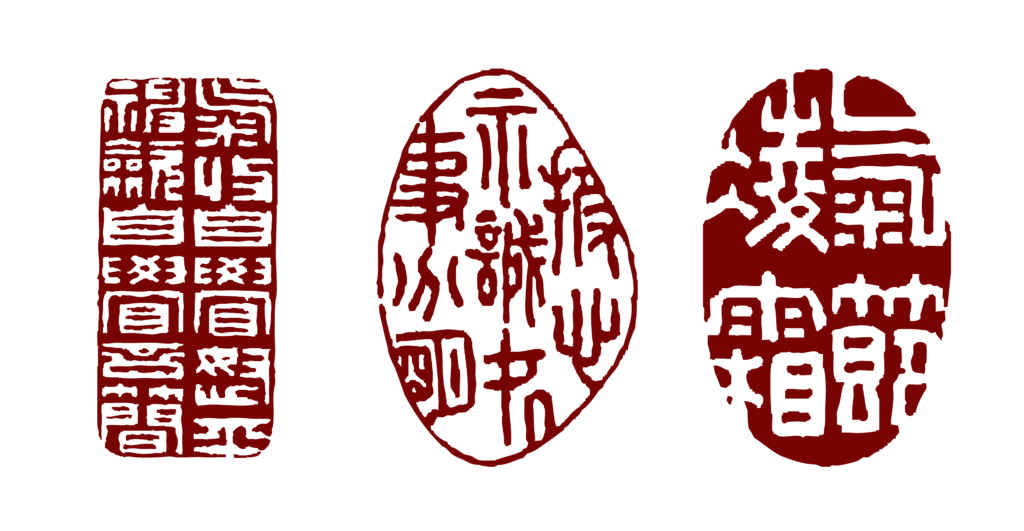In this article, we’ll delve into the fascinating realm of Japanese Hanko design by spotlighting a remarkable historical record known as the “Shijin Shinno Inpu” (熾仁親王印譜). This compilation of over 100 unique seal impressions from a distinguished member of the imperial family serves as both artifact and artistic inspiration. Whether you’re new to the concept of Japanese Hanko or already a design enthusiast, you’ll find plenty to spark your imagination in this timeless tradition.
The Origins and Uniqueness of Japanese Hanko Design
For centuries, Japanese Hanko have played an essential role in verifying documents, signifying personal or official authority, and representing an individual’s very identity. Different from a mere signature, a Japanese Hanko’s engraved characters can take various forms—ranging from delicately curved scripts to bold, stylized lines. Ancient imperial seals once denoted political influence, while temple stamps underscored spiritual reverence. Over time, this tradition expanded to the samurai class and, eventually, the general population. Today, nearly every individual in Japan keeps at least one Hanko, making it a cultural staple with deep roots and ongoing relevance.
Prince Arisugawa Taruhito: A Patron of Art and Culture
Among the Japanese imperial lineage, certain figures stand out not only for their status but for their cultural pursuits as well. One such individual was Prince Arisugawa Taruhito, who demonstrated a refined taste for art, literature, and design. While he occupied a position of distinction, his legacy in the arts reveals a fascination with calligraphy, seal carving, and elegant script forms. This enthusiastic engagement led to the creation of a comprehensive seal album, offering a vivid look into both his aesthetic preferences and the broader seal-making culture of the time.
Inside Shijin Shinno Inpu
Shijin Shinno Inpu is effectively a curated anthology of Prince Arisugawa’s personal seal impressions. Far from a static catalog, each page radiates character and creativity. The prints showcase:
- Regal Imagery. Formal seals engraved with official titles or poetic lines reflect the prince’s high-ranking status.
- Artistic Collaboration. Notable calligraphers and seal carvers of the era contributed their skills, blending traditional lettering styles with innovative flair.
- Cultural Insight. Every impression tells a story—about the times he lived in, his personal mottoes, and even the web of connections between Japan’s imperial household and its artistic communities.
Historical Context

- Transition into the Modern Era: While Japan modernized swiftly after the mid-19th century, the practice of crafting official seals grew in tandem with new administrative procedures.
- The Prince’s Influence: As a figure with notable social ties and personal interests in the arts, he collected seals that transcended simple utility, forging them into expressions of both identity and artistry.
Lasting Significance

- Resource for Scholars: Shijin Shinno Inpu continues to be an invaluable source for art historians, calligraphy experts, and cultural researchers studying the evolution of Japanese Hanko design.
- Enduring Reverence: Beyond academia, art lovers are drawn to these prints for their refined motifs and sense of timeless beauty.
Appreciating Japanese Hanko as Art
To behold a Hanko impression is to glimpse a uniquely Japanese aesthetic. The red ink resonates against the paper, while the carved lines capture an elegant dance of strokes. In the context of architecture and design, these intricate seals often find their way into interior motifs or personal collections, adding a subtle touch of history and sophistication. If you’re intrigued by this synergy between past and present, exploring digital art shops can offer modern interpretations of Hanko-inspired designs that blend effortlessly into contemporary living spaces.
Japanese Hanko design, at its core, represents far more than an ancient method of signature or documentation. It symbolizes a tapestry of personal narratives, age-old craftsmanship, and artistic ingenuity. The story within Prince Arisugawa Taruhito’s Shijin Shinno Inpu underscores just how pivotal seals have been in weaving cultural identity through every era.
Whether you’re drawn to the subtle power of calligraphy, fascinated by the heritage behind each carved line, or eager to discover fresh design ideas for your home or personal stationery, Hanko offers a window into Japan’s aesthetic soul. May this foray into the world of Shijin Shinno Inpu spark a deeper appreciation for the artistry behind the simple, yet profound imprint of red ink on paper—and inspire you to see your own signature, and your own story, in a whole new light.




